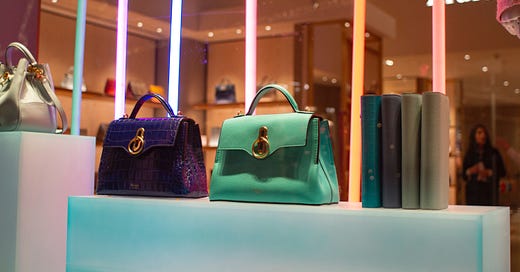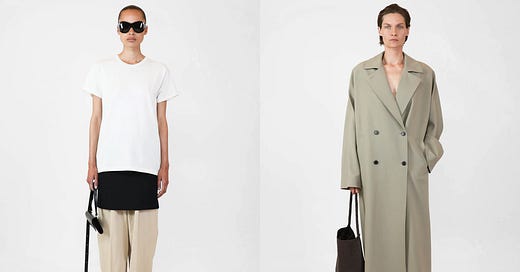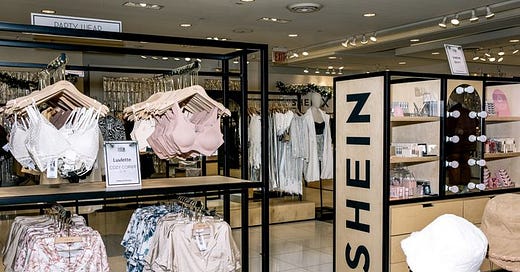

Discover more from Back Row
Thank you for subscribing to Back Row, fashion’s fastest growing independent newsletter. If you like these posts, please share them with your friends. This newsletter is powered by readers and every subscriber counts. If you are new here, tap that button and join the community.
Recently I went to Saks Fifth Avenue in Manhattan. It was a weekday afternoon in the middle of a pandemic and most of the people in the store were staff. The first floor is handbags. A lot of handbags. Some hanging near cash registers, some encased in glass. Some with logos, some with hardware. Some in neutral colors, others in neon. Every conceivable type of handbag laid before me as though this were some kind of handbag shelter: Won’t you please take me home?
The sheer magnitude of that pristine assemblage of never-touched purses haunts me. Because it’s impossible to read daily about fashion and not think about “sustainability,” I am acutely aware that there is nothing “sustainable” about this quantity of stuff. And these were just handbags by luxury labels, which don’t produce nearly as many collections or items as fast fashion companies like Zara and H&M.
It seems improbable that there is a buyer for every single one of those handbags (on the website, the store lists 3,534!). The store is 10 floors, 650,000 square feet, each full of racks filled with more stuff. Buzzy labels you’ve read about in Vogue like Wales Bonner and legacy brands like Burberry. Exit the store on Fifth Avenue and you’re confronted with more stores filled with more stuff. Aldo and Michael Kors, Uniqlo and Ferragamo. Again, it was a pandemic weekday, international tourism in the city is not at usual levels, but the street was empty.
Who buys all the stuff?
It’s impossible to say, but it’s a safe bet that much of it probably isn’t bought by anyone. This is why apparel companies destroy a disturbing amount of unsold stuff, the cost being the health of our planet. Last month, former Timberland COO Kenneth P. Pucker wrote an article for Harvard Business Review titled “The Myth of Sustainable Fashion.” It’s worth a full read, but I’ll highlight the thesis:
Few industries tout their sustainability credentials more forcefully than the fashion industry. Products ranging from swimsuits to wedding dresses are marketed as carbon positive, organic, or vegan while yoga mats made from mushrooms and sneakers from sugar cane dot retail shelves. New business models including recycling, resale, rental, reuse, and repair are sold as environmental life savers.
The sad truth however is that all this experimentation and supposed “innovation” in the fashion industry over the past 25 years have failed to lessen its planetary impact — a loud wake up call for those who hope that voluntary efforts can successfully address climate change and other major challenges facing society.
Take the production of shirts and shoes, which has more than doubled in the past quarter century — three quarters end up burned or buried in landfills.
It’s unclear exactly what percentage of global carbon emissions fashion accounts for, but Pucker cites a McKinsey and the Global Fashion Agenda study that places it at 4 percent, and a U.N. study that places it at 10 percent.
The business model for fashion has long been broken, and our post-pandemic lives, I predict, will reveal it to be even more broken than we thought it was when all those fashion businesses went bust in 2020. Business of Fashion recently published a terrific feature on Proenza Schouler by Lauren Sherman, who expertly illustrates just how backwards the system in which brands survive and thrive truly is.
Proenza was started in 2002 by talented then-Parsons students Jack McCollough and Lazaro Hernandez. Then-Barneys buyer Julie Gilhart bought their entire senior thesis collection. Anna Wintour became a fan and supporter. To say they had everything going for them would be an understatement. What followed was years of industry adoration, including becoming recipients of the inaugural CFDA/Vogue Fashion Fund award and three subsequent CFDA Awards for Womenswear Designer of the Year (2007, 2011, and 2013). Proenza’s runway shows have been, season after season, some of the hottest New York Fashion Week tickets (excluding those couple of seasons when they showed at Paris Couture). Chief executive Kay Hong said that the label will break even in 2021 and post profit this year. Yet, after 20 years of industry support, the label has had just one main commercial success: the PS1 handbag. Sherman writes:
For several years following the launch, the bag accounted for 80 percent of handbag sales, and made up the majority of the company’s overall revenue.
A decade later, though, the PS1, while still a top seller, had fallen out of fashion, and the designers had yet to have another blockbuster product or a stable of items that sold reliably year after year.
Several years after the PS1 came out, pressure mounted for McCollough and Hernandez — beholden to the investors keeping them afloat — to create another hit product. However, Hernandez said, “You can’t plan a hit bag.”
All the while, Proenza Schouler never missed runway shows, which are necessary both for clout in the industry and to indicate to retailers that you have new stuff for them to sell in their stores. However, for years those shows were mainly in service of boosting sales of a single style of handbag.
This model of buzz generation isn’t unique to Proenza. You know all those ready-to-wear shows we see each season? Many of them (Bottega Veneta, Chanel, Saint Laurent, Balenciaga) are elaborate marketing displays for a core handbag/leather goods business.
In what world does it make sense that designers like McCollough and Hernandez had to keep producing new collections in order to keep one bag afloat and try to find another one that could replicate the PS1’s success? It doesn’t make any sense. Under pressure from investors to increase and diversify sales, the designers had to make compromises, Sherman reports:
With the label unable to sustain or replicate the success of the PS1, the board became frustrated with the designers’ focus on the increasingly costly runway collection at the expense of commercial product.
“The commercial collection was a watered down version of the show,” McCollough said. “There was a big disconnect with what was being sold and what was being shown.”
This week, New York Fashion Week begins. This particular fashion week is known as a place where new labels can get their start. Young designers will put on shows in attempt to replicate the buzz that Proenza Schouler earned before its designers had even finished school. The industry will rally behind some of these shows, celebrating all this new stuff. In a sense, this is the right thing to do. New designers are laying their creativity bare in the hope of making it — an incredibly difficult thing to do on a personal and financial level — and they should be supported and praised and given a chance.
However, the troubling message all these fashion shows sends to consumers is that new stuff is good, that we all need to buy new things to keep up with fashion. The industry sorely needs to find a better model for upstart creative talent to succeed. (Alternatives do exist, like Aurora James’s Brother Vellies, which employs artisans around the globe and doesn’t mark anything down ever. The Brother Vellies website says products’ “value is assigned based on materials and fair labor practices, which are unaffected by the traditional commercial consumption cycle.”)
I want to be clear that I do not blame young designers or Proenza Schouler for this system in the slightest. The problem is the system itself, which forces labels like Proenza to showcase a lot of things that people aren’t buying and don’t need. The majority of consumers can’t afford a thing that comes down fashion week runways. But being exposed to this system for so long has trained them to desire constant new fashion. They will satisfy that desire by shopping at fast fashion companies like Shein and Zara, which have knocked off many a runway look by Proenza and countless other labels. Back to Pucker in HBR:
According to SimilarWeb, [Shein’s] web site ranks number one in the world for web traffic in the fashion and apparel category. Selling tops for $7, dresses for $12 and jeans for $17, Shein makes Zara and H&M look expensive and slow.
The scary thing about the fashion industry today is that there aren’t many great solutions to the sustainability problem. The best so far is probably the bill that New York legislators are considering, which will come up for a vote in the spring and would require fashion brands with more than $100 million in revenue that do business in the state to make certain disclosures about their supply chain, including things like carbon emissions, water usage, and worker wages. Then, at least, consumers can know if what they’re buying is made ethically. Big brands operating in shameful or harmful ways will probably clean up their acts rather than face a potential PR nightmare through disclosures.
But this doesn’t really address the consumer psyche, the voice in the vast majority of our heads urging us to buy new stuff. While fashion’s brand-led “sustainability” push has failed, maybe the lasting impact it will have had is on people who never thought of themselves as activists but couldn’t avoid being subjected to it. As a result of reading about useless sustainability initiatives for years, we are now painfully aware of fashion’s impact on the planet. Therefore, when we walk into stores like Saks, we feel horror instead of desire. And that shift in consumer mindset, in a world where lawmakers move at a distressingly inadequate pace on climate legislation, is essential.
Previously in Back Row: "It's a Monster": Aja Barber on the Fashion Industry
If you are new here, please subscribe to Back Row to get posts like this delivered in your inbox two to three times a week.













I don’t know exactly when I started entering stores and feeling horror instead of “surprise & delight” but it feels like a permanent shift for me. And I thought I was alone in that feeling, but apparently not. Thanks for your sharp analysis and prolific (seriously, Amy, WTF!) writing.
Such an interesting read. The amount if waste is absolutely crazy. I'm not sure consumers care enough, we're so used to new, new, new. I've started buying pre-worn precisely because of the climate issue. Just sooo much stuff is produced...shameful really. Love your work btw!